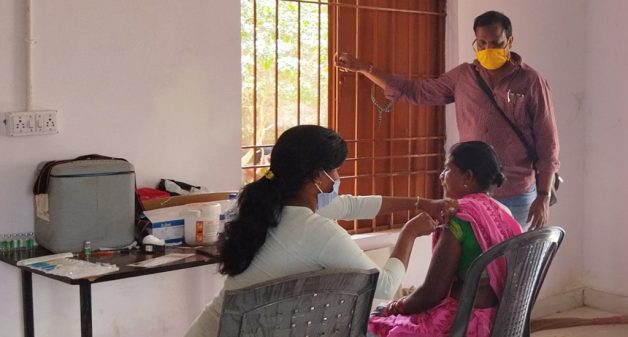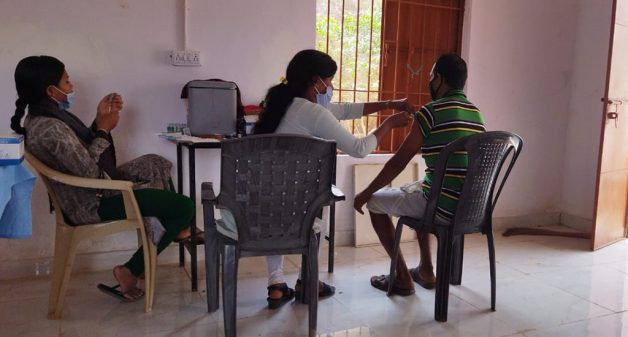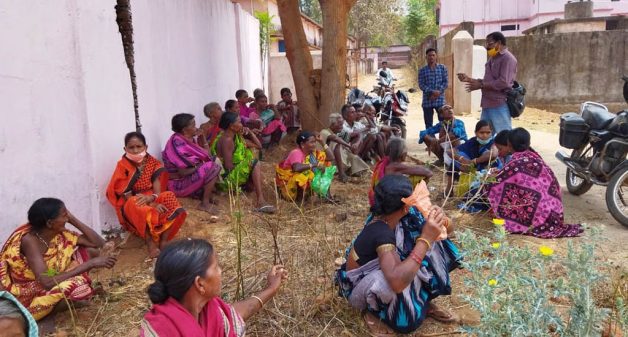On 24 May, the central government allowed walk-in vaccinations at government hospitals for people in the 18-44 age bracket, but the states are yet to take decisions in this regard. Activists working among marginalized groups, especially in remote areas of Odisha, feel this cannot help achieve universal vaccination.
Since the central government’s announcement, making it mandatory for the 18-44 age group people to register in the Co-WIN portal to get vaccinated, the vulnerable sections feel deprived as they find digital registration a barrier. This is more visible in remote villages of Odisha where internet connectivity is poor.
Every individual above 18 years has the right to get vaccination; but mandatory registering on Co-WIN makes it difficult for many. To ensure this right of the rural people, Odisha government has to bring changes in its vaccination plan.
Digital divide
Sunakar Jani (26), lives in a remote village under Gunupur panchayat of Thuamul Rampur administrative block, a hilly area in Kalahandi district, where internet connectivity is sporadic. Besides, he does not possess a smart phone and he is digitally illiterate even if he had one. So, he has not yet registered in the Co-WIN app for vaccination.
“I have a simple phone, which I use only to make calls. I don’t have enough money to buy a smart phone,” Jani told VillageSquare.in, over phone from his village which is 72 km from the Kalahandi district headquarter Bhawanipatna.
The village Kathaghara, where Jani lives, has 110 households and among them only 10 youths possess smart phones. These youths had migrated to other states for work, and from their earnings they purchased smart phones.
“They have very little knowledge in using smart phones. They climb a tree or a hill and watch videos only. They don’t know how to register in government’s Co-WIN app,” said Jani, adding that if the state allowed walk-in vaccination, it would solve his problem.

In Kalahandi district, till 21 May, 2,29,969 persons had been vaccinated; among them 47,826 persons had received both the doses, as per the vaccination dashboard. In the 18-44 age group, only 13,867 had received the jab. In Thuamul Rampur block, 5,479 persons have received the jab, though the data does not indicate how many of them are under 45.
Gurubaru Parabhoi (32), a volunteer working with a non-profit organization in Thuamul Rampur block said, “Those who are 45 and above were allowed to get a jab without a prior appointment, but for the 18-44 age group registration in Co-WIN is a must. That deters people from poor communities in remote villages to get vaccinated.”
“Villagers who have received their first dose were unable to register for the second dose. Some do not even know that the date by which they should have taken the second dose has passed,” Parabhoi told VillageSquare.in.
Parabhoi has registered himself and four members of his family through Co-WIN. Though he uses a smart phone, he said that it was not easy for him to register and so he took the help of his senior in Bhawanipatna. “When it was not easy for me to register, how can you expect illiterate people in this remote village? Most of them have not seen or touched a smart phone in their life.”
Lack of connectivity
The overall tele-density in Odisha is 76.46, while the national average is 87.37, as per Odisha Economic Survey 2020-21. Internet subscription per 100 people in rural areas is 34.51 while it is 85.98 in urban areas. Besides, there is significant urban-rural difference in the state, both for tele-density and internet subscription.
Parabhoi said that in Thuamul Rampur block there are two mobile towers. But there are small hilltop villages like Kelua and Kinmali, where villagers do not have smart phones and they rarely come down to the foothills. The men who come downhill for PDS or monthly pensions have to cross narrow streams and forests. Registering for vaccines would be more difficult for villagers in these remote areas.
Kelua and Kinmali are only two examples of many inaccessible villages that do not have mobile connectivity. A survey conducted by the Department of Telecommunications, Government of India reveals that 11,000 of the total 51,311 villages of Odisha do not have mobile connectivity.
Language barrier
Suresh Majhi (24) lives in Pipalpadar, one of the villages in Swabhiman anchal, formerly known as the cut-off area in Chitrakonda administrative block of Malkangiri district. After the construction of Gurupriya Setu (bridge) to connect the cut-off villages, mobile towers were set up in a few villages.
Though some youths possess smart phones, registering for vaccination becomes difficult since most of them do not read English or are illiterate. Suresh Majhi is one among them who found it difficult to register. “It is in English so I have not been able to register yet,” said Majhi, who is scared of the recent surge in infections in rural areas.

In Odisha, though the literacy rate is 72.9%, Malkangiri has one of the lowest literacy rates, as per 2011 Census. India has 22 official languages listed in Eighth Schedule of the Constitution. But Co-WIN is currently accessible only in English.
Limited access for women
For rural women, it is more difficult to register for the vaccine through Co-WIN. “When the vaccination drive started for people above 45, my father got vaccinated. He goes out so we thought vaccination is more needed for him than my mother,” said Manju Majhi (18).
Only when the accredited social health activist (ASHA) convinced them, the mother and daughter decided to get themselves vaccinated. “Now, we don’t have a smart phone to register through the app, so we cannot get the jab,” Manju Majhi told VillageSquare.in.
According to National Family Health Survey 4, only 32.2% of rural women own and use mobile phones in Odisha, limiting their independence and opportunity. This reflects that for registration they have to depend on male members in the family or in the neighborhood.
Rukmini Panda, program officer, gender justice at Oxfam India said, “There are many systemic reasons which prevent women access health services, including vaccination,” she said. “In the patriarchal structure, women’s health needs are not prioritized in families.”
“Also, due to lack of information, rural women do not have awareness about benefits of vaccination,” Panda told VillageSquare.in. Hence government needs to create awareness, considering women and the differently-abled people in particular.
Vaccination right
“Registration made mandatory through the app excludes the poor and the marginalized from the drive. Thus, there is a need to make the system off-line,” Gouranga Mohapatra, national joint convener, Jan Swasthya Abhijan, a network of organizations, told VillageSquare.in.
“Central government’s walk-in vaccination decision is welcome but to reach people in remote villages, government should open vaccination centers in anganwadis; and for the vulnerable group they should start doorstep vaccination,” said Mohapatra.

In remote villages, the ASHA and anganwadi workers have a detailed list of villagers and they can facilitate the vaccination. Citizen’s Collective for Public Heath, a network that works on increasing health equity in Odisha has urged the state government to prioritize vaccination in districts with high test positivity rates.
Dillip Das, an activist who works among marginalized communities in Kalahandi district said, “For people living in remote areas, government should provide vehicles to bring them to vaccination centers.” The government has to change its vaccination plan, so that its inclusive, and youth like Sunakar Jani are not left out.
Rakhi Ghosh is a Bhubaneswar-based journalist. Views are personal. Email: rakhighosh@rediffmail.com


